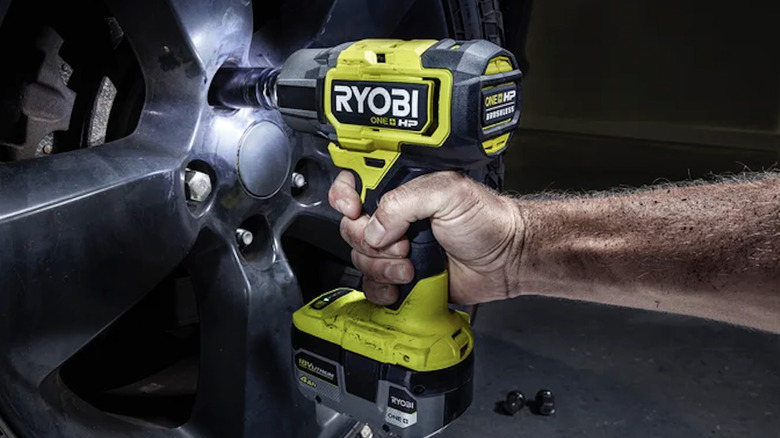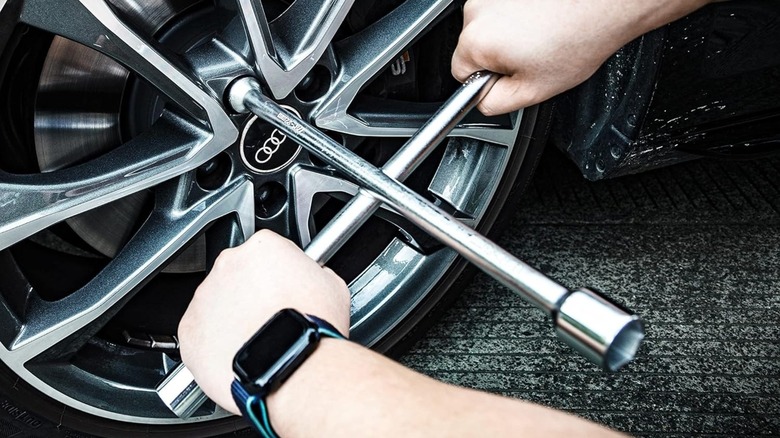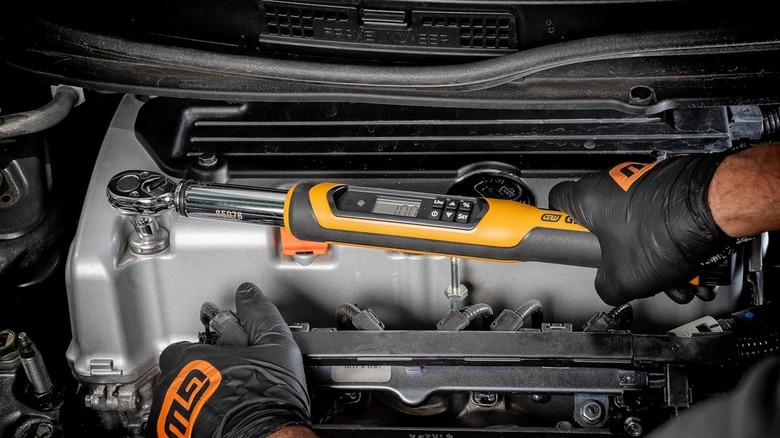Don't Use Ryobi's Impact Driver To Remove Lug Nuts — This Is The Tool You Need
We may receive a commission on purchases made from links.
It's not unheard of to use an impact driver to remove lug nuts when changing or rotating your tires, but it's not the best tool for the job and could cost you in the long run. Removing lug nuts requires a certain amount of torque — the level of force needed to rotate and loosen each fastener around its axis. In the U.S., it's usually measured in inch-pounds or foot-pounds. If a lug nut is tightened to 100 ft-lb, you would need to apply 100 pounds of force to a one-foot lever to loosen it.
The lug nuts for a specific tire and automobile should be set to the torque that's recommended by the manufacturer. Smaller cars typically require 70-90 ft-lbs, while other sedans may require up to 100 ft-lbs. SUVs and crossovers require more, and the lug nuts of truck tires can require up to 160 ft-lbs of torque. A lug nut that's stuck from cold temperatures or rust can often require a lot more than that, as anyone who's tried to break a rusted bolt can tell you.
While they can generate enough torque to loosen some fasteners, even the best impact wrenches aren't powerful enough for all of them, especially stuck or over-tightened ones. Ryobi's most powerful impact driver maxes out at around 183 ft-lbs, and most impact drivers deliver far less. You risk damaging the lug nut, and worse, breaking your impact driver when trying to loosen a fastener it's not strong enough to handle. Impact drivers also require adapters for lug nuts, which are weaker and more vulnerable to breaking. That's why Ryobi says not to use its impact drivers on wheel nuts, and instead recommends a different tool — the impact wrench.
Other tools that can remove lug nuts if you don't have an impact wrench
Compared to an impact driver, an impact wrench offers much more torque for removing stuck lug nuts. Plus, impact wrenches with a ½-inch square drive don't require adapters to fit a standard lug nut. While Ryobi's most powerful impact driver produces up to approximately 183 ft-lbs of torque, its 18V One+ HP 4-mode ½-inch High-Torque Impact Wrench (model PBLIW01B) delivers up to 1,170 ft-lbs of breakaway torque, a difference of nearly 1,000 feet. All Ryobi impact wrenches offer more torque than its impact drivers — even its least-powerful model, the ⅜-inch 3-speed P263, is capable of 220 ft-lb of torque.
Generally speaking, any well-made impact wrench from any brand should be your first choice when removing lug nuts. If you don't have one on hand, there are a couple of other options you could get away with, though are not effective or useful as impact wrenches. A breaker bar – like the WORKPRO 16-inch Dual Drive Breaker Bar — allows you to break nuts and bolts loose by applying good old-fashioned brute force. This is because it's longer than a typical wrench, so it's adding in-lbs of additional torque to the force you're applying.
It obviously takes a lot more labor to use and is more inconvenient to twist the fastener off once it's loose (you may end up using your fingers). It's also slower and needs more space than an impact wrench. But, a breaker bar is one of the tools that are fine to buy cheap, and it's good to have as a backup for your impact wrench. Similarly, a lug wrench (also called a cross wrench) can be used to manually remove lug nuts with the same downsides of the breaker bar. It usually takes more effort than a breaker bar because it has shorter arms.
The best tool for tightening lug nuts isn't an impact driver or impact wrench
While an impact wrench can be useful for getting a bolt snug and tightening it some of the way, it's unable to set it to a specific torque. That's a problem because it's important that lug nuts are set as close as possible to the manufacturer's recommended torque. Over-tightening can damage or break the wheel stud or warp the brake rotor or wheel hub, while not fastening lug nuts with enough torque could even cause you to lose a wheel. If all the lug nuts on a tire aren't tightened to the same torque, the wheel could vibrate or pulsate.
That's why you should only use a torque wrench to fasten your lug nuts, since it allows you to set a specific torque. Many torque wrenches include a scale or meter that you can line your shaft up with the torque you need. As you tighten, the wrench will click or give some other notice that you've reached your desired torque, so you can stop before overtightening. Some torque wrenches, such as the Gearwrench 3/8 Drive Electronic Torque Wrench, have digital displays and notifications to make things even easier.
This requires some manual effort, unlike an impact wrench. You can use an impact wrench to get started, but you'll need to finish tightening with a torque wrench to reach your target torque. Ryobi doesn't make a motorized torque wrench — Milwaukee is one of the only major tool brands with such a device. Milwaukee's M18 Fuel torque wrenches are incredibly convenient ways to fasten lug nuts, but are very expensive. Torque sticks (also known as torque extension bars) can be an alternative to torque wrenches but are considered less accurate than torque wrenches, which can get you within 2- and 4% of your targeted torque.


